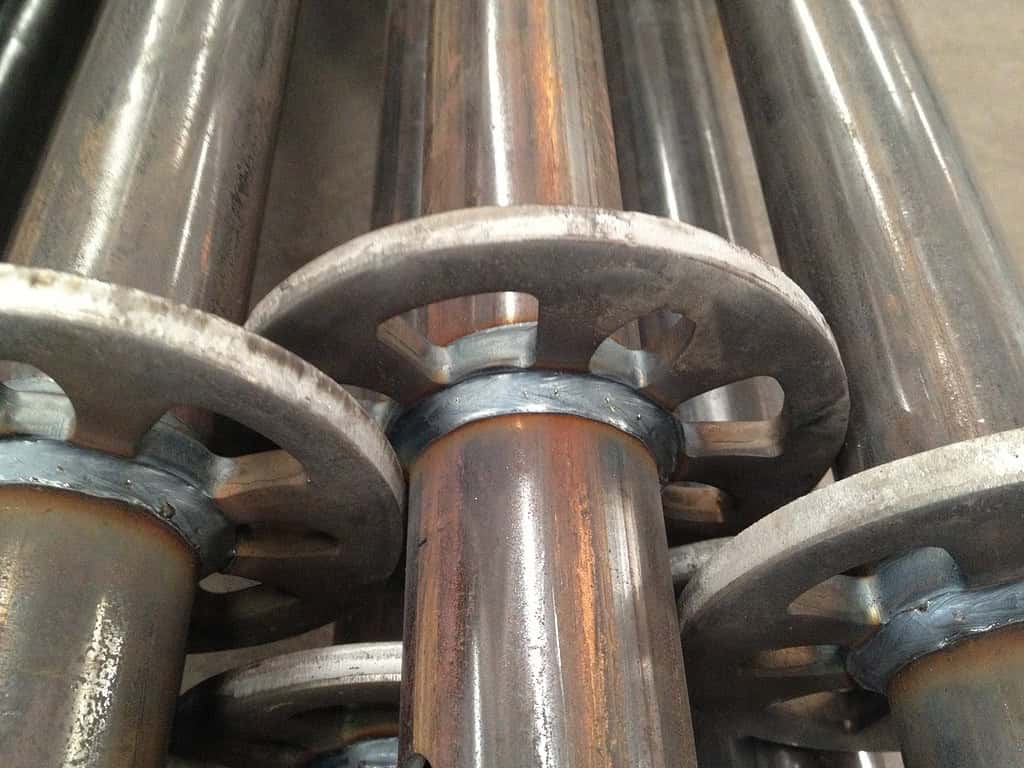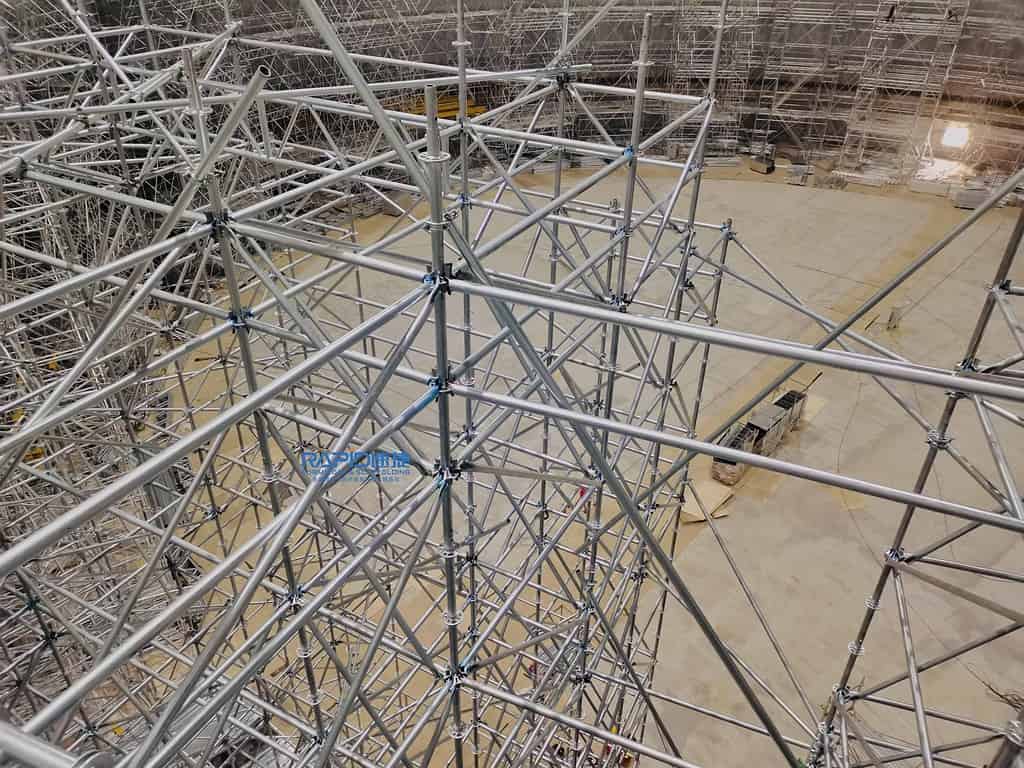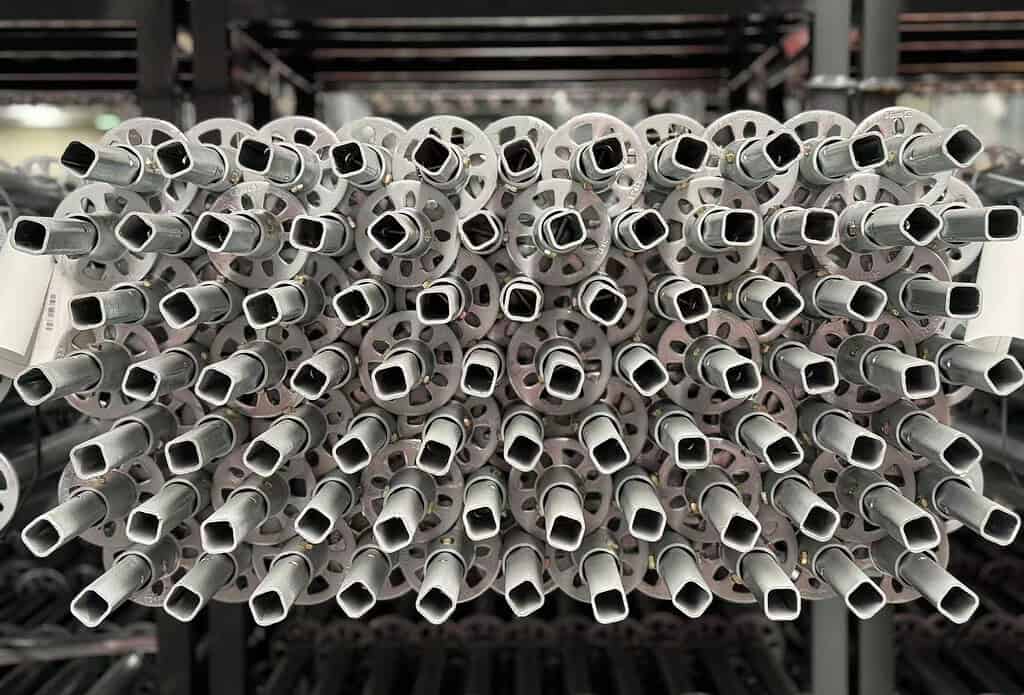In modern construction, scaffolding is more than just a support system—it’s the backbone of safety and efficiency on site. And when it comes to scaffolding, the choice of materials can be the difference between a solid, secure structure and one that’s less reliable. Among the different scaffolding systems available, Ringlock Scaffolding stands out for its exceptional load-bearing capacity, safety features, and quick assembly. At the core of this system is the vertical (also is called standard), and the material most commonly used for it is Q355 steel. But what makes Q355 the go-to choice for vertical poles? In this blog, we’ll dive into the reasons why Q355 steel is the ideal material for scaffolding.

What is Q355 Steel?
Q355 is a type of low-alloy, high-strength structural steel. The “Q” represents its yield strength, which is 355 MPa (megapascals). This high yield strength makes Q355 perfect for applications where load-bearing capacity and durability are critical. In fact, most global scaffolding standards, especially in major construction markets, require that vertical poles be made from materials that meet or exceed the strength of Q345/Q355.
Why Not Use Q355 for All Scaffolding Parts?

While Q355 steel is the best choice for vertical poles, other components, like horizontal (ledger) and diagonal brace, are usually made from materials such as Q235 or Q195. Why? Because different parts of the scaffolding system face different types of stress:
- Scaffolding Vertical (scaffolding standard): These bear the main load, as they carry the weight directly downwards. That’s why they need the superior strength of Q355 to ensure stability under heavy loads.
- Horizontal and Diagonal brace: These parts mainly provide lateral support and don’t face the same vertical stress. Materials like Q235, which have moderate strength, are more than sufficient for these roles.
The Benefits of Using Q355 for Scaffolding Vertical
1. High Load-Bearing Capacity
Q355’s high yield strength ensures that scaffolding vertical can handle significant loads without failing. In tests, Q355 poles have shown far superior load-bearing capacity compared to traditional scaffolding materials. For example, a standard Q355 scaffold vertical can bear up to 99.1 kN, while a heavy-duty version can withstand up to 136.5 kN.
2. Durability and Impact Resistance
Q355 steel is incredibly durable, with excellent resistance to impact, even in harsh conditions like cold weather. Its toughness minimizes the risk of brittle fractures, making it safer and more reliable for long-term use. This is especially important in construction environments where the scaffolding is exposed to wear and tear.
3. Versatility and Flexibility
Using Q355 steel doesn’t just mean stronger scaffolding vertical—it also allows for more flexible scaffolding designs. Contractors can use fewer materials to achieve larger scaffolding spans, giving workers more internal space to operate. This flexibility can help reduce material costs and speed up project timelines, offering both economic and practical advantages.
The Importance of Quality Control in Q355 Scaffolding Verticals
However, simply using Q355 steel isn’t enough. The way the steel is processed—particularly when it’s turned into pipes—can affect its performance. Research shows that both elongation and toughness can decrease during the manufacturing process. Additionally, the quality of the welds, especially at the joints, is crucial for ensuring the scaffolding’s overall strength and stability. That’s why rigorous quality control is essential to guarantee the finished product meets safety standards.
Understanding the Load-Bearing Capacity of B-Type and Z-Type Scaffolding Vertical in Ringlock Scaffolding
Ringlock Scaffolding is known for its superior load-bearing capacity and robust design, making it a preferred choice for many construction projects. We explore the B-Type ( Traditional ) and Z-Type (Heavy Duty) scaffolding verticals, both made from high-strength Q355 steel, and present the calculated and tested load-bearing capacities.
B-Type vs. Z-Type Verticals: Key Differences
| Type | Outer Diameter (mm) | Wall Thickness (mm) | Sectional Area (mm²) | Moment of Inertia (mm⁴) |
|---|---|---|---|---|
| B-Type | 48.3 | 3.2 | 453 | 16.0 |
| Z-Type | 60.3 | 3.2 | 574 | 20.2 |
The primary difference between the two types lies in their diameter and load-bearing capacity, which affects their performance in scaffolding systems.
Calculated Maximum Load-Bearing Capacity

Using the formulas specified by safety technical regulations, the maximum allowable design load-bearing capacities for the verticals are as follows:
| Type | Stability Coefficient (φ) | Max Load (kN) |
|---|---|---|
| B-Type (48.3mm) | 0.350 | 47.6 |
| Z-Type (60.3mm) | 0.516 | 88.9 |
These values are derived from the stability coefficient (φ) for Q355 steel and the specific characteristics of each vertical type.
Experimental Load-Bearing Test Results
To verify the calculated capacities, real-world load-bearing tests were conducted with the following setup:
- Vertical Spacing: 1500 mm (longitudinal and transverse)
- Step Height: 1500 mm
- Full Diagonal Bracing
The results from these tests show the actual load-bearing performance of the verticals.
| Type | Ultimate Load for 4 Poles (kN) | Ultimate Load per Pole (kN) |
|---|---|---|
| B-Type | 396.3 | 99.1 |
| Z-Type | 546.0 | 136.5 |
These test results clearly demonstrate that the load-bearing capacity of a single scaffold vertical pole in the Ringlock system far exceeds that of traditional scaffolding poles. This higher load capacity allows for a wider scaffold span, increasing the internal workspace and providing greater flexibility for on-site operations. Moreover, this advantage helps reduce material consumption and shortens project timelines, ultimately translating into direct economic benefits for clients.
The comprehensive load-bearing tests highlight the strength and reliability of Ringlock Scaffolding, especially when using Q355 steel for scaffolding vertical poles. Whether you’re working on high-rise buildings, bridges, or large-scale industrial projects, the superior performance of B-Type and Z-Type vertical poles offers a clear advantage in terms of both safety and efficiency.
Key Takeaways
- Superior Load Capacity: Both the B-Type (99.1 kN) and Z-Type (136.5 kN) scaffolding vertical poles significantly outperform traditional scaffolding systems, offering enhanced stability and safety.
- Efficiency Gains: The higher load capacity allows for fewer materials and wider scaffold spans, reducing costs and shortening construction timelines.
- Safety Assurance: Using Q355 steel and rigorous testing ensures that both B-Type and Z-Type poles are highly reliable and can safely meet the demands of large-scale projects.
Conclusion
In summary, Q355 steel stands out as the ideal material for vertical poles in Ringlock scaffolding, thanks to its exceptional load-bearing capacity, impact resistance, and durability. Its strength in supporting heavy loads and withstanding tough environmental conditions ensures both safety and efficiency on construction sites. Whether opting for B-Type or Z-Type verticals, contractors benefit from reduced material usage, faster assembly, and improved project timelines. By choosing Q355 steel for your scaffolding system, you’re investing in long-term reliability, enhanced safety, and significant cost savings.
If you’re looking to learn more about scaffolding materials or need high-quality Ringlock scaffolding, feel free to reach out to us. We’d be happy to help!

